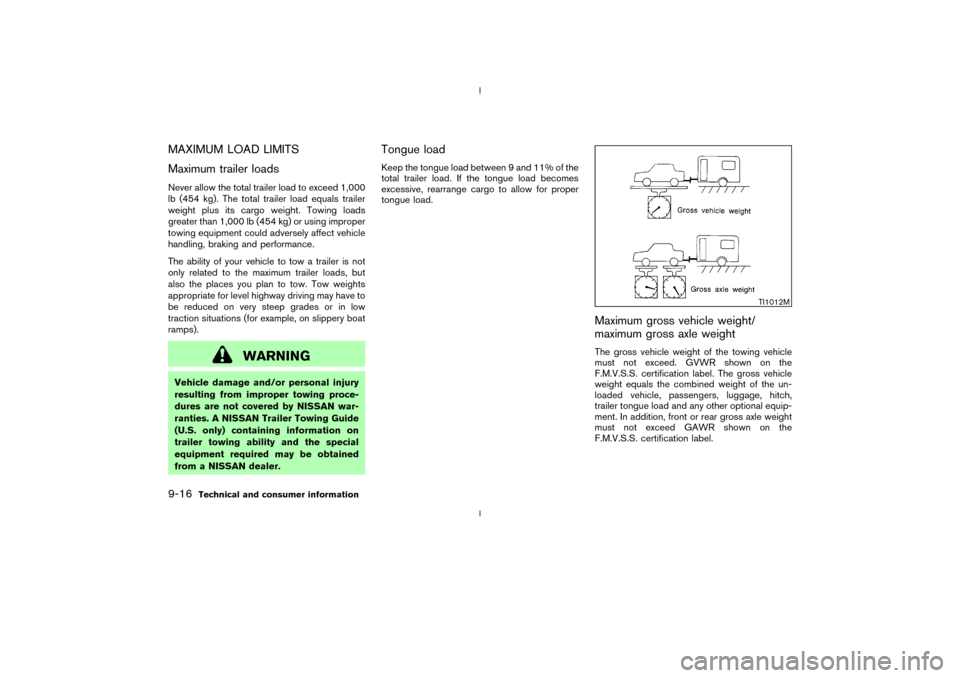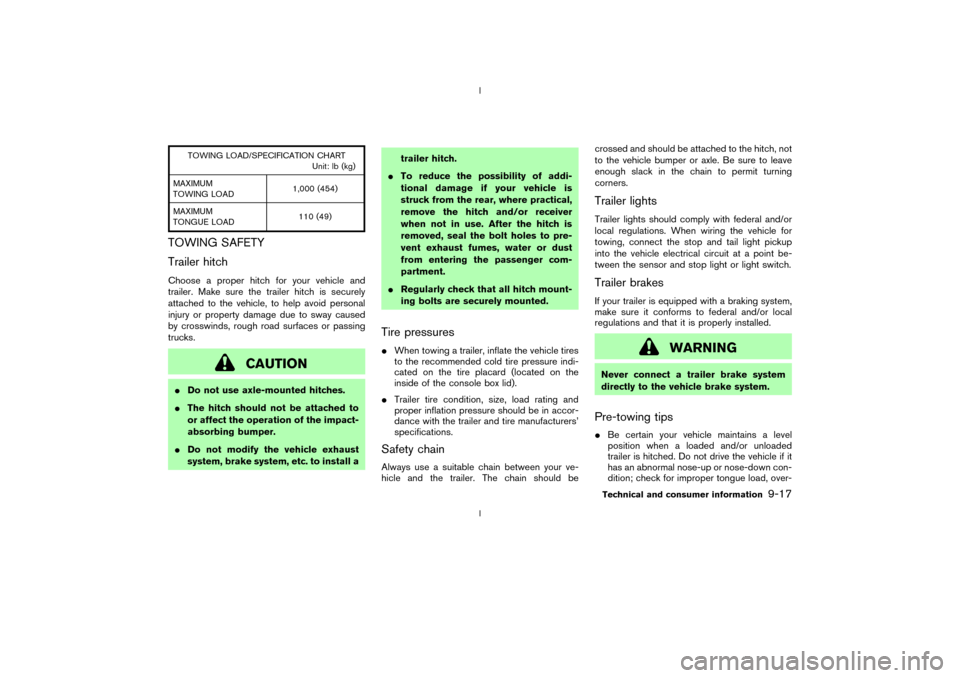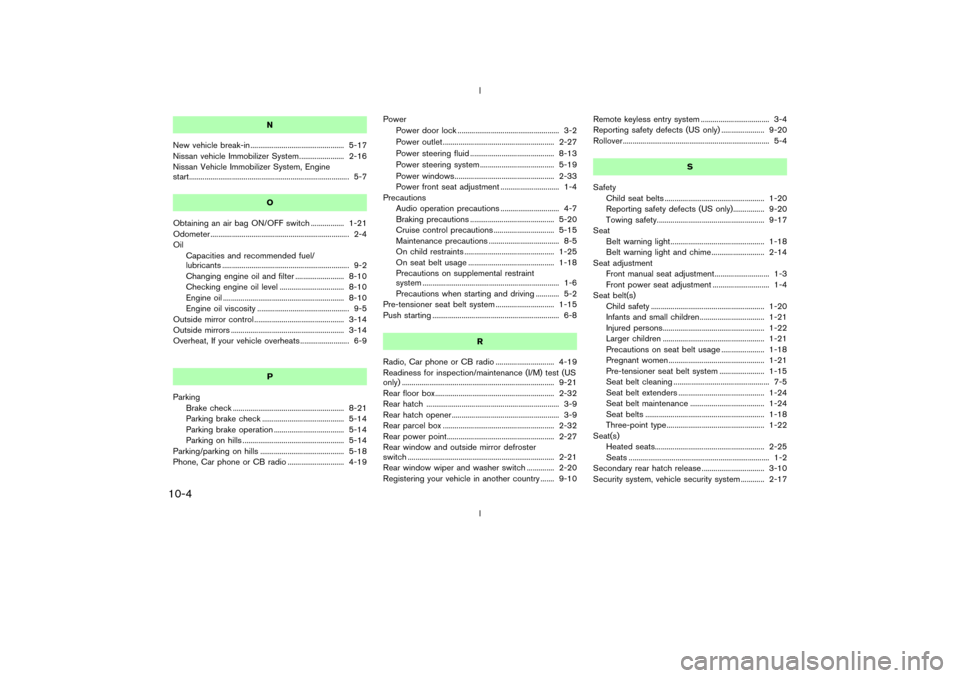2003 NISSAN 350Z towing
[x] Cancel search: towingPage 211 of 227

MAXIMUM LOAD LIMITS
Maximum trailer loadsNever allow the total trailer load to exceed 1,000
lb (454 kg). The total trailer load equals trailer
weight plus its cargo weight. Towing loads
greater than 1,000 lb (454 kg) or using improper
towing equipment could adversely affect vehicle
handling, braking and performance.
The ability of your vehicle to tow a trailer is not
only related to the maximum trailer loads, but
also the places you plan to tow. Tow weights
appropriate for level highway driving may have to
be reduced on very steep grades or in low
traction situations (for example, on slippery boat
ramps).
WARNING
Vehicle damage and/or personal injury
resulting from improper towing proce-
dures are not covered by NISSAN war-
ranties. A NISSAN Trailer Towing Guide
(U.S. only) containing information on
trailer towing ability and the special
equipment required may be obtained
from a NISSAN dealer.
Tongue loadKeep the tongue load between 9 and 11% of the
total trailer load. If the tongue load becomes
excessive, rearrange cargo to allow for proper
tongue load.
Maximum gross vehicle weight/
maximum gross axle weightThe gross vehicle weight of the towing vehicle
must not exceed. GVWR shown on the
F.M.V.S.S. certification label. The gross vehicle
weight equals the combined weight of the un-
loaded vehicle, passengers, luggage, hitch,
trailer tongue load and any other optional equip-
ment. In addition, front or rear gross axle weight
must not exceed GAWR shown on the
F.M.V.S.S. certification label.
TI1012M
9-16
Technical and consumer information
Z
02.9.13/Z33-D/V5.0
X
Page 212 of 227

TOWING LOAD/SPECIFICATION CHART
Unit: lb (kg)
MAXIMUM
TOWING LOAD1,000 (454)
MAXIMUM
TONGUE LOAD110 (49)
TOWING SAFETY
Trailer hitchChoose a proper hitch for your vehicle and
trailer. Make sure the trailer hitch is securely
attached to the vehicle, to help avoid personal
injury or property damage due to sway caused
by crosswinds, rough road surfaces or passing
trucks.
CAUTION
IDo not use axle-mounted hitches.
IThe hitch should not be attached to
or affect the operation of the impact-
absorbing bumper.
IDo not modify the vehicle exhaust
system, brake system, etc. to install atrailer hitch.
ITo reduce the possibility of addi-
tional damage if your vehicle is
struck from the rear, where practical,
remove the hitch and/or receiver
when not in use. After the hitch is
removed, seal the bolt holes to pre-
vent exhaust fumes, water or dust
from entering the passenger com-
partment.
IRegularly check that all hitch mount-
ing bolts are securely mounted.
Tire pressuresIWhen towing a trailer, inflate the vehicle tires
to the recommended cold tire pressure indi-
cated on the tire placard (located on the
inside of the console box lid).
ITrailer tire condition, size, load rating and
proper inflation pressure should be in accor-
dance with the trailer and tire manufacturers'
specifications.Safety chainAlways use a suitable chain between your ve-
hicle and the trailer. The chain should becrossed and should be attached to the hitch, not
to the vehicle bumper or axle. Be sure to leave
enough slack in the chain to permit turning
corners.
Trailer lightsTrailer lights should comply with federal and/or
local regulations. When wiring the vehicle for
towing, connect the stop and tail light pickup
into the vehicle electrical circuit at a point be-
tween the sensor and stop light or light switch.Trailer brakesIf your trailer is equipped with a braking system,
make sure it conforms to federal and/or local
regulations and that it is properly installed.
WARNING
Never connect a trailer brake system
directly to the vehicle brake system.Pre-towing tipsIBe certain your vehicle maintains a level
position when a loaded and/or unloaded
trailer is hitched. Do not drive the vehicle if it
has an abnormal nose-up or nose-down con-
dition; check for improper tongue load, over-Technical and consumer information
9-17
Z
02.9.13/Z33-D/V5.0
X
Page 213 of 227

load, worn suspension or other possible
causes of either condition.
IAlways secure items in the trailer to prevent
load shifts while driving.
IBe certain your rear view mirrors conform to
all federal, state or local regulations. If not,
install any mirrors required for towing before
driving the vehicle.
Trailer towing tipsIn order to gain skill and an understanding of the
vehicle's behavior, you should practice turning,
stopping and backing up in an area which is free
from traffic. Steering stability, and braking per-
formance will be somewhat different than under
normal driving conditions.
IAlways secure items in the trailer to prevent
load shift while driving.
IAvoid abrupt starts, acceleration or stops.
IAvoid sharp turns or lane changes.
IAlways drive your vehicle at a moderate
speed.
IAlways block the wheels on both vehicle and
trailer when parking. Parking on a slope is not
recommended; however, if you must do so,
and if your vehicle is equipped with automatic
transmission, first apply the parking brakeand block the wheels, and then move the
transmission selector lever into the P (Park)
position. If you move the selector lever to the
P (Park) position before blocking the wheels
and applying the parking brake, the transmis-
sion may get damaged.
IWhen going down a hill, shift into a lower
gear and use the engine braking effect.
When ascending on a long grade, downshift
the transmission to a lower gear and reduce
speed to reduce chances of engine overload-
ing and/or overheating.
IIf the engine coolant rises to an extremely
high temperature when the air conditioning
system is on, turn off the air conditioner.
Coolant heat can be additionally vented by
opening the windows, switching the fan con-
trol to high and setting the temperature con-
trol to the HOT position.
ITrailer towing consumes more fuel than nor-
mal circumstances.
IAvoid towing a trailer for the first 500 miles
(800 km).
IHave your vehicle serviced more often than at
intervals specified in the recommended main-
tenance schedule.
IWhen making a turn, your trailer wheels will
be closer to the inside of the turn than yourvehicle wheels. To compensate for this, make
a larger than normal turning radius during the
turn.
ICrosswinds and rough roads will adversely
affect vehicle/trailer handling, possibly caus-
ing vehicle sway. When being passed by
larger vehicles, be prepared for possible
changes in crosswinds that could affect ve-
hicle handling. If swaying does occur, firmly
grip the steering wheel, steer straight ahead,
and immediately (but gradually) reduce ve-
hicle speed. This combination will help stabi-
lize the vehicle. Never increase speed.
IBe careful when passing other vehicles.
Passing while towing a trailer requires con-
siderably more distance than normal passing.
Remember the length of the trailer must also
pass the other vehicle before you can safely
change lanes.
ITo maintain engine braking efficiency and
electrical charging performance, do not use
6th gear (manual transmission) or 5th posi-
tion (automatic transmission).
IAvoid holding the brake pedal down too long
or too frequently. This could cause the brakes
to overheat, resulting in reduced braking ef-
ficiency.
When towing a trailer, change transmis-9-18
Technical and consumer information
Z
02.9.13/Z33-D/V5.0
X
Page 223 of 227

N
New vehicle break-in ................................................ 5-17
Nissan vehicle Immobilizer System....................... 2-16
Nissan Vehicle Immobilizer System, Engine
start.................................................................................. 5-7
O
Obtaining an air bag ON/OFF switch ................. 1-21
Odometer ....................................................................... 2-4
Oil
Capacities and recommended fuel/
lubricants ................................................................. 9-2
Changing engine oil and filter ......................... 8-10
Checking engine oil level ................................. 8-10
Engine oil .............................................................. 8-10
Engine oil viscosity ............................................... 9-5
Outside mirror control .............................................. 3-14
Outside mirrors .......................................................... 3-14
Overheat, If your vehicle overheats ......................... 6-9
P
Parking
Brake check ......................................................... 8-21
Parking brake check .......................................... 5-14
Parking brake operation .................................... 5-14
Parking on hills .................................................... 5-14
Parking/parking on hills ........................................... 5-18
Phone, Car phone or CB radio ............................. 4-19Power
Power door lock .................................................... 3-2
Power outlet ......................................................... 2-27
Power steering fluid ........................................... 8-13
Power steering system ...................................... 5-19
Power windows................................................... 2-33
Power front seat adjustment .............................. 1-4
Precautions
Audio operation precautions .............................. 4-7
Braking precautions ........................................... 5-20
Cruise control precautions ............................... 5-15
Maintenance precautions .................................... 8-5
On child restraints .............................................. 1-25
On seat belt usage ............................................ 1-18
Precautions on supplemental restraint
system ...................................................................... 1-6
Precautions when starting and driving ............ 5-2
Pre-tensioner seat belt system .............................. 1-15
Push starting ................................................................. 6-8
R
Radio, Car phone or CB radio .............................. 4-19
Readiness for inspection/maintenance (I/M) test (US
only) .............................................................................. 9-21
Rear floor box ............................................................. 2-32
Rear hatch .................................................................... 3-9
Rear hatch opener ....................................................... 3-9
Rear parcel box ......................................................... 2-32
Rear power point....................................................... 2-27
Rear window and outside mirror defroster
switch ........................................................................... 2-21
Rear window wiper and washer switch .............. 2-20
Registering your vehicle in another country ....... 9-10Remote keyless entry system ................................... 3-4
Reporting safety defects (US only) ...................... 9-20
Rollover........................................................................... 5-4
S
Safety
Child seat belts ................................................... 1-20
Reporting safety defects (US only)................ 9-20
Towing safety....................................................... 9-17
Seat
Belt warning light................................................ 1-18
Belt warning light and chime ........................... 2-14
Seat adjustment
Front manual seat adjustment............................ 1-3
Front power seat adjustment ............................. 1-4
Seat belt(s)
Child safety .......................................................... 1-20
Infants and small children ................................. 1-21
Injured persons.................................................... 1-22
Larger children .................................................... 1-21
Precautions on seat belt usage ...................... 1-18
Pregnant women ................................................. 1-21
Pre-tensioner seat belt system ....................... 1-15
Seat belt cleaning ................................................. 7-5
Seat belt extenders ............................................ 1-24
Seat belt maintenance ...................................... 1-24
Seat belts ............................................................. 1-18
Three-point type.................................................. 1-22
Seat(s)
Heated seats........................................................ 2-25
Seats ........................................................................ 1-2
Secondary rear hatch release ................................ 3-10
Security system, vehicle security system ............ 2-17
Z
02.9.13/Z33-D/V5.0
X
10-4
Page 224 of 227

Security systems (Nissan Vehicle Immobilizer
System), Engine start ............................................... 2-18
Security systems (See vehicle security
system) ......................................................................... 2-16
Servicing air conditioner ................................... 4-3, 4-6
Shift lock release ....................................................... 5-12
Shifting
Automatic transmission .............................. 5-5, 5-9
Manual transmission ................................. 5-6, 5-12
Side air bag system (See supplemental side air bag
and curtain side-impact air bag system)............. 1-13
Spark plugs................................................................. 8-17
Speedometer ................................................................ 2-4
Starting
Before starting the engine .................................. 5-8
Jump starting .......................................................... 6-6
Precautions when starting and driving ............ 5-2
Push starting .......................................................... 6-8
Starting the engine ............................................... 5-8
Steering
Power steering fluid ........................................... 8-13
Power steering system ...................................... 5-19
Tilting steering wheel......................................... 3-12
Storage ........................................................................ 2-29
Sunglasses holder .................................................... 2-29
Supplemental air bag warning labels................... 1-16
Supplemental air bag warning light .......... 1-16, 2-14
Supplemental front air bag system....................... 1-11
Supplemental side and curtain side-impact air bag
system ......................................................................... 1-13
Supplemental restraint system ................................. 1-6
Precautions on supplemental restraint
system ...................................................................... 1-6Switch
Hazard warning flasher switch ........................ 2-24
Headlight switch ................................................. 2-22
Ignition switch ........................................................ 5-5
Ignition switch automatic transmission
models ............................................................ 5-5, 5-9
Ignition switch manual transmission
models .......................................................... 5-6, 5-12
Obtaining an air bag ON/OFF switch........... 1-21
Power door lock switch....................................... 3-4
Rear window and outside mirror defroster
switch..................................................................... 2-21
Turn signal switch .............................................. 2-23
T
Tachometer.................................................................... 2-5
Temperature gauge, Engine coolant temperature
gauge .............................................................................. 2-5
Theft (Nissan Vehicle Immobilizer System), Engine
start ............................................................................... 2-18
Three way catalyst ....................................................... 5-3
Tilting and reclining passenger's seat .................. 1-5
Tilting steering wheel ............................................... 3-12
Tire
Flat tire ..................................................................... 6-2
Low tire pressure warning system .................... 5-3
Uniform tire quality grading .............................. 9-19
Tire pressure, Low tire pressure warning
light ............................................................................... 2-13
Tires
Spare tire .............................................................. 8-33
Tire chains ............................................................ 8-31
Tire placard .......................................................... 9-12Tire pressure ........................................................ 8-29
Tire rotation .......................................................... 8-31
Types of tires ....................................................... 8-30
Wheel/tire size ....................................................... 9-9
Wheels and tires ................................................ 8-29
Top tether strap child restraints ............................ 1-27
Towing
Tow truck towing ................................................ 6-10
Towing a trailer.................................................... 9-15
Towing load/specification chart ...................... 9-15
Towing safety....................................................... 9-17
Traction control system (TCS)............................... 5-22
Traction control system (TCS) off switch ........... 2-26
Trailer towing .............................................................. 9-15
Transceiver, HomeLink
Universal
Transceiver .................................................................. 2-36
Transmission
Automatic transmission fluid (ATF) ................ 8-12
Driving with automatic transmission........ 5-5, 5-9
Driving with manual transmission .......... 5-6, 5-12
Transmission selector lever lock release ...... 5-12
Transmitter (See remote keyless entry system) ... 3-4
Traveling or registering your vehicle in another
country ......................................................................... 9-10
Trip computer ............................................................... 2-8
Turn signal switch ..................................................... 2-23
U
Underbody cleaning .................................................... 7-3
Uniform tire quality grading .................................... 9-19
Z
02.9.13/Z33-D/V5.0
X
10-5